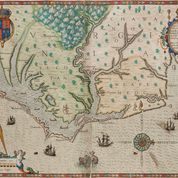As one of the chief gateways for the earliest explorers and settlers of North America, Virginia possesses a long cartographic heritage. Moving from the years preceding Jamestown to the dawn of the post-Civil War era, “Mapping Virginia,” published by the University of Virginia Press, represents the most comprehensive available selection of printed maps from Virginia’s first 300 years.
Author William C. Wooldridge, a U.Va. School of Law alumnus, amassed a private collection of maps over several decades. He has served as president of the John Marshall Foundation and of the Norfolk Historical Society, as well as chairing the map support group of the Library of Virginia.
Written for the general reader as well as the map connoisseur, the book, published in November, provides a detailed listing of the vast majority of the printed maps drawnbefore 1830. A large selection depicting Virginia during the Civil War is also included.
Beginning with the first, tentative renderings of the mid-Atlantic coast in the 16th century, the maps collected here reflect an evolving idea of what Virginia is, a concept as much as a strict region – the lands and themes that came to mind at various points in time when a cartographer designed what he believed conveyed “Virginia.”
Because the legal and popularly conceived boundaries of Virginia were in flux for many generations, the maps encompass a great deal of geography not presently part of the commonwealth.
The hundreds of illustrations, more than half in color, display the artistry of the draftsman’s, engraver’s and colorist’s craft. The maps are all reproduced through abundant illustrations, and each is placed in its historical context.
Wooldridge recently talked about the maps on an episode of the “Kojo Nnamdi Show,” aired on National Public Radio affiliate WAMU in Washington.
Long after Columbus, Wooldridge said, many explorers and mapmakers thought the Pacific lay not far beyond Virginia – a 10-day journey, according to one. A long period of grappling with the basic shape of the land finally gave way to surveying, the drawing up of state and county lines, as Virginia and the rest of the country were carved into sharply defined properties.
Margaret Beck Pritchard of the Colonial Williamsburg Foundation wrote of the book, ‘“Mapping Virginia’ provides a richly illustrated, comprehensive and insightful view of how mapmakers perceived Virginia and how their vision changed over time to influence the cultural identity of the birthplace of our nation.
“Wooldridge has meticulously researched over 300 of the most important and influential Virginia maps to provide an invaluable cartographic and historical resource that must certainly adorn the bookshelves of anyone interested in either history or maps,” she said.
The book was published for the Library at the Mariners’ Museum, in association with the Virginia Cartographical Society.
Media Contact
Article Information
December 17, 2012
/content/book-maps-covers-virginia-age-exploration-civil-war

